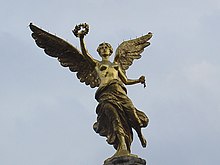This article has multiple issues. Please help improve it or discuss these issues on the talk page . (Learn how and when to remove these messages)
|



Enrique Alciati (died after 1912) was a French/Italian sculptor and teacher, born in Marseille, France, who contributed various sculptures in France and Mexico. His most notable artwork is the Winged Victory that crowns the Independence Column in downtown Mexico City.